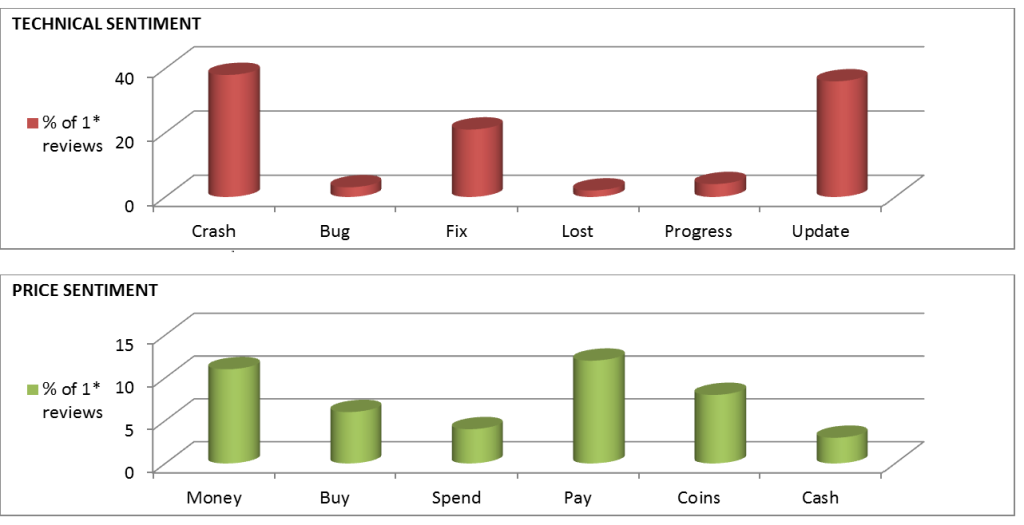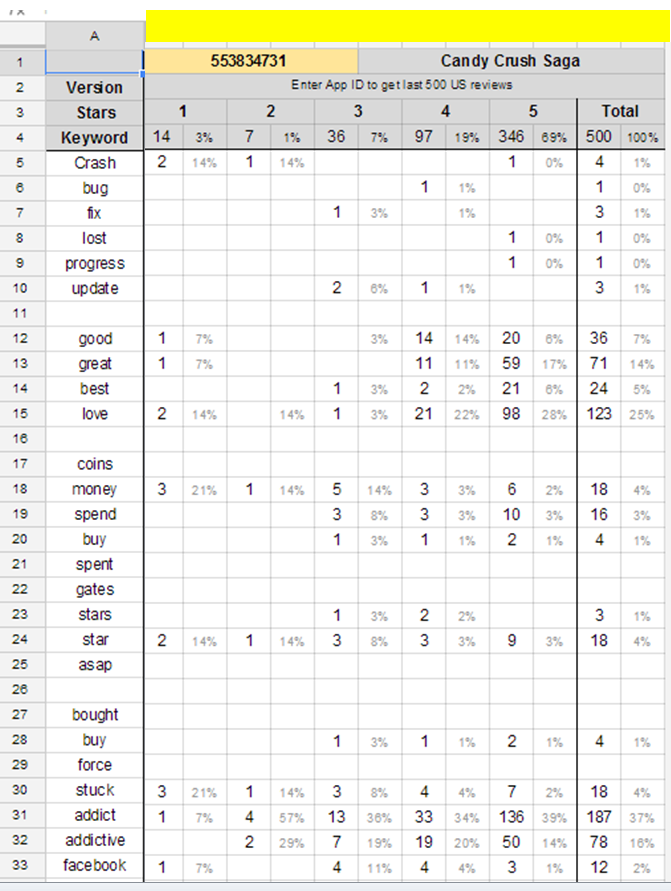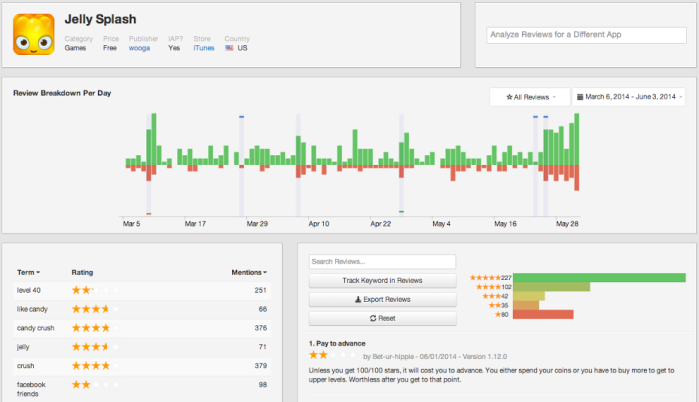Review Mining: The App Publisher’s Secret Weapon
Mobile App Growth
November 30, 2018

Guest post by Tom Leclerc (Wooga).
App Store Reviews: The Undiscovered World
How many companies – and not just in the app industry, would say no to a substantial number of free, unsolicited, unpromoted customer opinion surveys?
Not many, right? But that’s exactly what we’re doing as an industry, on an almost wholesale level. I’m talking, of course, about user reviews and the enormously valuable information they contain.
It’s only the most progressive, or the richest companies that are investing in review mining.
Why is that? I guess it has to be because the perceived value of reviews is too low. What can you learn from them? You can’t change them if they’re bad, and there’s no problem if they’re good, so why bother?
That theory doesn’t really hold much water any more, as far as I’m concerned. And here’s why.
Getting the Competitive Edge
So possibly the strongest and simplest argument against ignoring reviews is that you have literally millions of voices, all telling you what they want in their apps. Using this wealth of information has gone from merely being sensible to being fantastically useful.
We all know the app stores are incredibly competitive places, and you simply don’t stand much of a chance unless you listen to the people that decide whether you’re going to be a success or not. But that’s just common sense, isn’t it?
Using reviews in the concept and prototyping phases of your app development allows you to get a much clearer overview of what your market wants. So, if you’re creating a Saga-style matching puzzle game, for example, doing a little review mining will bring up reviews like this: “I can’t get past road blocks/gates. This is so annoying! Deleting app!” You’ll see it a few times, and after correlating some data, this sentiment will wind up forming the basis of 30-40% of all the negative reviews in the genre. In the genre! That’s the biggest genre (depending on your metric) in the biggest category on iTunes.
So what do you do with this information?
Well, if you believe in creating happy users, you’d likely direct your monetization efforts some place other than gates.
Bear in mind that this is not something limited to games. Indeed, for more functional apps, review mining actually becomes easier, as you’re dealing with much more focused feedback in general.
Understanding Your Failures
If you have an app already out there, you can still use your reviews to establish your points of success and failure. This differs from competitor review analysis in that your view is narrowed from many apps within the genre, to one specific app: yours.
However, before you start delving into your data, it’s good to establish benchmarks. Here at Wooga, we use a technique called the hit-filter to produce games we know will become hits. This involves a good deal of market analysis. As part of this, I use reviews to build a picture of what a successful game looks like. One of the most interesting discoveries I made during this was that every one of the top grossing apps on iTunes bar one (Game of War – Fire Age) had an extremely low number of negative reviews. This figure varied between 7% to 1%, but the mean sits at around 4.5%.
When you start looking further down the scale, reviews start becoming far more varied. Just taking a snapshot of those mid-level titles that have seen a degree of success, you start to see negative review rates of between 30% and 75%. So, not only does this have an impact on the human side of things – reviews and ratings are an important metric to decision making – but it also has an effect on an algorithm level.
So simply in terms of monetization, it pays to have a good look at your ratings and listen to reviews in order to combat the issues your users are telling you about.
Sentiment Analysis: The New Metric
Past simply looking at the number of positive and negative reviews, as well as the specifics of what your users are saying, it can also be helpful to group reviews and create an idea of sentiment, using groups of keywords.
This is not easy to do, or even that easy to understand, if you’re not in the business of sentiment analysis. Indeed, there has been a good degree of high-level study put into the concept. At the most basic level, it involves grouping together keywords into themes that may be more meaningful than more straightforward analysis of high-frequency words.
A good example of this comes from the Free To Play model. For many users, the FTP model is something of a turn off. We all know that a vast majority of players never purchase items. However, is this something that is more of a turn off in general than, say, technical issues?If you’re not sure, sentiment analysis is something that can really help.
Collecting the kind of information you can see below can help you prioritize the issues that really matter to users.

Keyword Generation
Another oft-overlooked element of review mining is in keyword generation.
One of the best ways of discovering those hidden gems that all optimizers love, is to trawl the positive reviews in the genre or category you’re working in. I have found many a great hidden keyword through review mining. What’s more, this is something that scales down very well. Smaller developers can also make great use of this, as they’re more likely to be looking for really targeted keywords that also have less competition.
One of the most important aspects of any sales writing (of which I consider keywording a part) is to ensure that you’re speaking to your audience in terms they can readily understand. This is very easily done by taking a look through reviews.
One example that comes from games is that you will very often see the words ‘addict’, ‘great’, ‘love’ and ‘cute’ pop up in game reviews. But do you want to include those words in your keywords? Probably not all of them, but both ‘cute’ and ‘addict’ appear to be highly underused keywords.
Obviously, this is something that is more or less valid depending on the type of app you’re producing, as well as the marketing spend behind it.
Sourcing the Data
The Basic Package
Knowing what to do with this data is one thing, but knowing how to get hold of all this juicy info is entirely another.
The first, and most time consuming way of sourcing this data is manually. iTunes allows you to filter and view reviews into most helpful, most critical, most favorable, and most recent. You can also filter by latest version or overall. In general, looking at the latest version, particularly with larger apps, makes the most sense. These refining parameters are just about enough to get together some decent data, thankfully, making it a viable option for a smaller developer, or those just getting into review mining.
This method does have certain advantages. Ultimately, reviews are qualitative in nature, and this method allows you to understand more on an individual level.
In addition, if you’re just starting with review mining, it gives you a good understanding of the problems inherent in more complex ways of doing things. For example, you can begin to see the limitations of single word analysis. Indeed, phrase matching can be a far safer way of doing things, despite offering less conclusive data. Also, this is something that anyone can do. It simply requires time and a little preparation to ensure you’re finding the data you need.
The Regular Reviewer
The problem with manual review mining is that it takes a good deal of time to both collect and analyze data. This isn’t really suitable for developers that are interested in keeping up-to-date with what’s going on in the industry.
If you’re looking to review mine on a regular basis, a good option is to build your own review mining tool. As developers, this is something that may well be doable relatively easily. This can be as complex as you have the capability to create, or it can be a matter of an excel spreadsheet that allows you to copy/paste reviews from sources such as Appannie, and break them down on a wholesale level.

The real bonus of this is that it can save you a good deal of money. It’s also perfectly tailored to your needs. For developers that only occasionally want to dive into their reviews, this makes a good deal of sense. However, building this tool can be expensive and time consuming, depending on how complex you want to go, and it may make more sense to buy into an existing review mining package.
The Luxury Package
The two best products on the market from my point of view are the enterprise packages from Sensortower and MobileDevHQ.
Without going into detail about these, both are elements of larger packages that also give you a suite of tools to help you gain better visibility across the app ecosystem. Their real advantage is that they offer seriously robust review mining tools, as well as ASO professionals that can help guide you through the process, the results and points of action. With these tools you can quickly and easily get a handle on both the language and the sentiment of those people reviewing apps right across the app store. You can also get direct comparisons with the competition, which gives you an excellent point of reference.

The one big down side to these powerful tools is expense. These can be costly, especially if you already have the other elements of the enterprise packages that are being offered. A few thousand Euros per month solely for a review mining tool is hard to justify. However, combining this with the localization elements of the enterprise plans as well as the in-depth knowledge offered by a professional app store optimizer may be much more in line with your budget.
The area of review mining is one that isn’t essential for everyone in the industry to be involved in.
Just yet.
While it’s incredibly useful for keyword generation, language and sentiment analysis, and competitor assessment, it’s also something that can help you understand why your app may not be performing as well as it can. Ultimately, user reviews are there for a reason; that reason is to make apps better and deliver a more tailored experience to everyone using the app store.
From a personal point of view, I hope app reviews stay a strong part of the app store algo. They’re difficult to game, thanks to iTunes’ swift and powerful banhammer, and they provide real insight into an app’s value.
I strongly believe that those in the industry that get ahead of the game in terms of review mining stand a much better chance of creating apps that shoot to the top and stay there.
***
About the author:
Tom Leclerc is App Store Optimization Manager at Wooga, located in the heart of Europe’s start-up capital, Berlin. He works to support developers of Wooga’s mobile and social games – from the fun, cuddly Jelly Splash to adventure titles, such as the story-driven Pearl’s Peril – with day-to-day keywording, testing and uploading.
Tom is an award-winning sales writer, blogger, SEO/ASO consultant, and has spent the last decade working for numerous high-profile companies including DHL, Hyatt Hotels Corp, Which? consumer group and UNISON, the UK’s largest trade union.
Hit him up on twitter @TomLeclerc2, for up-to-date ASO news and tips. Tom lives in Berlin with his PC and Xbox.
- Engage, Retain, Earn: Growth Strategy for Game Apps [Based on Data] - 15 September 2022
- How to do App Store Optimization step-by-step: a full cycle of ASO in the App Store and Google Play - 9 August 2022
- The Importance of A/B Testing - 13 January 2022


Very efficiently written information. It will be beneficial to anybody who utilizes it, including me. Keep up the good work. For sure i will check out more posts. This site seems to get a good amount of visitors.